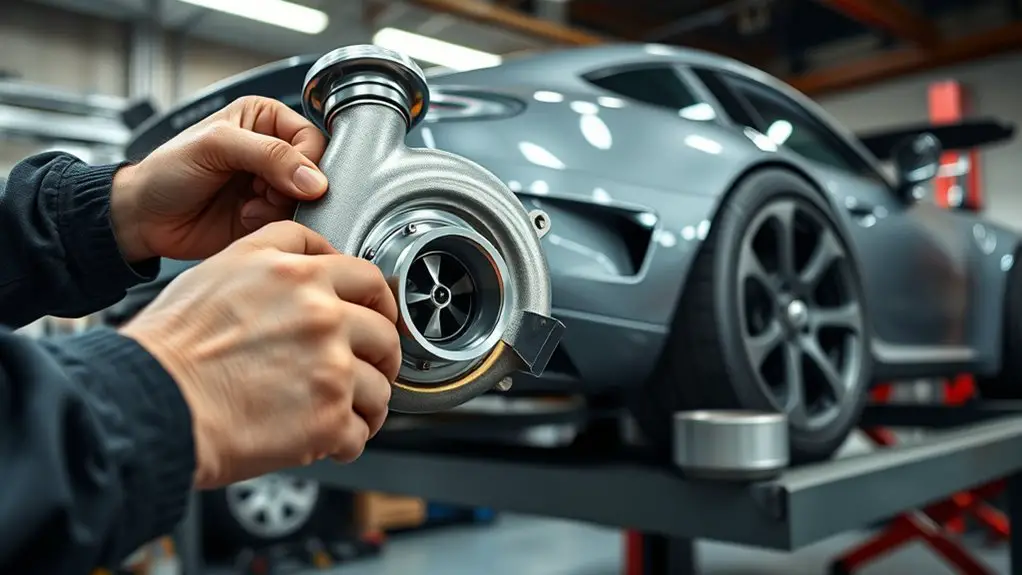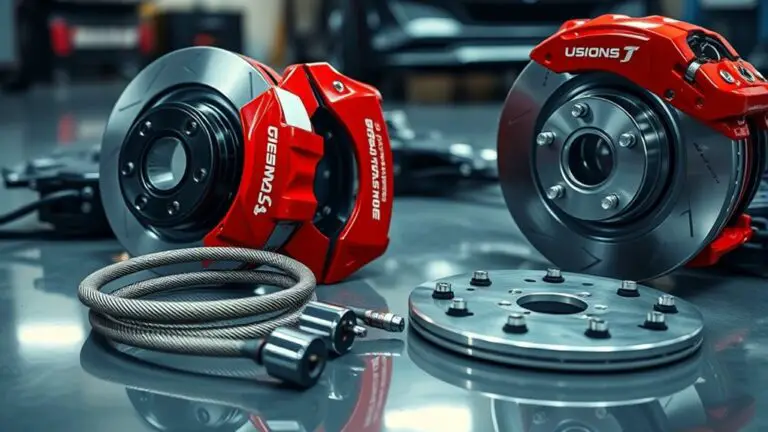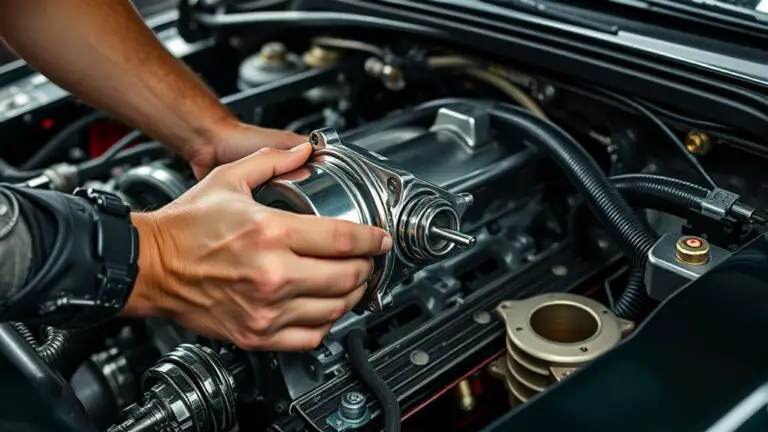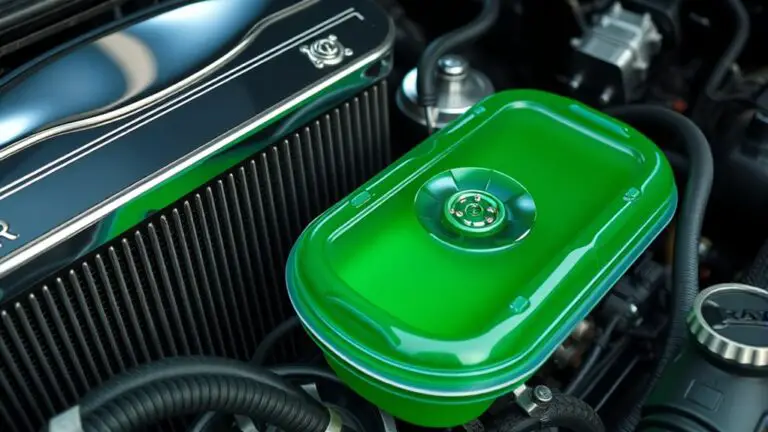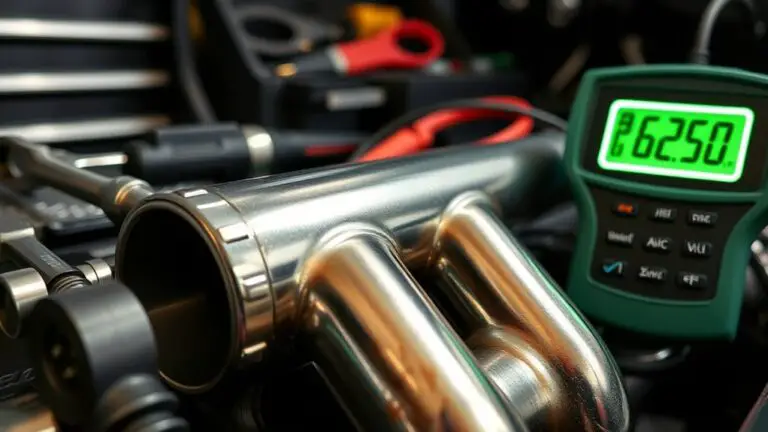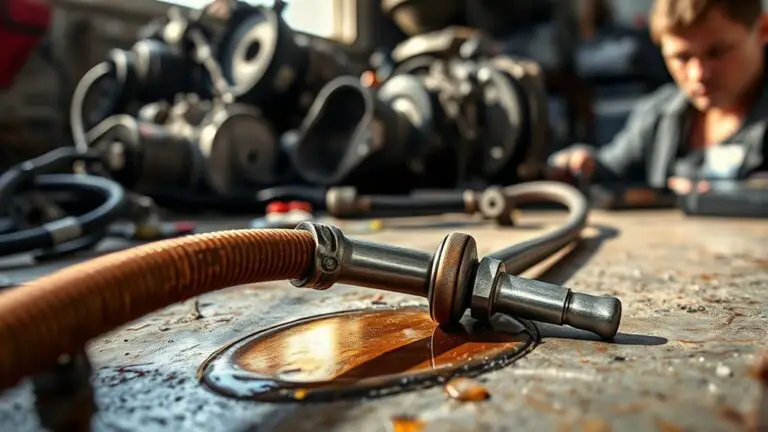Preventive Maintenance to Avoid Turbo Lag in High-Mileage Car
To prevent turbo lag in your high-mileage car, prioritize regular oil changes with quality synthetic oil for peak engine lubrication. Inspect and replace air filters every 15,000 to 30,000 miles to guarantee clean airflow. Monitor coolant levels and maintain your turbocharger by checking for wear on intake and exhaust sides, along with oil supply lines. Keeping your exhaust system in good condition also helps. Follow these guidelines closely, and you’ll uncover additional valuable maintenance tips.
Understanding Turbo Lag and Its Causes
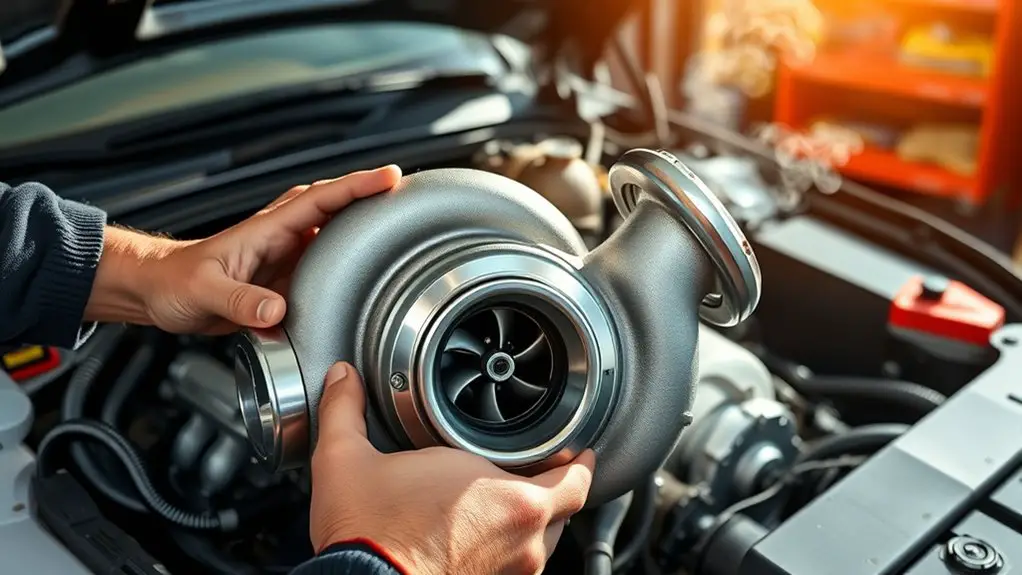
While you might enjoy the thrill of turbocharged performance, understanding turbo lag is essential for maximizing your car’s efficiency and responsiveness. Turbo lag occurs due to the time it takes for exhaust gases to spool the turbocharger, impacting its functionality. When you accelerate, there’s a brief delay before the turbo responds, leading to a moment where power feels diminished.
This phenomenon can be influenced by several factors, including engine size, turbocharger design, and exhaust flow dynamics. Smaller, more responsive turbos often reduce lag, enhancing performance with quicker power delivery. However, larger turbos may provide greater peak power but can exacerbate lag.
To mitigate turbo lag, consider performance enhancements like upgraded wastegates or tuning your engine management system. These modifications can optimize turbocharger functionality, allowing for a more immediate throttle response and improved driving experience, ultimately granting you the freedom to enjoy your high-performance ride.
Regular Oil Changes and Quality Lubrication
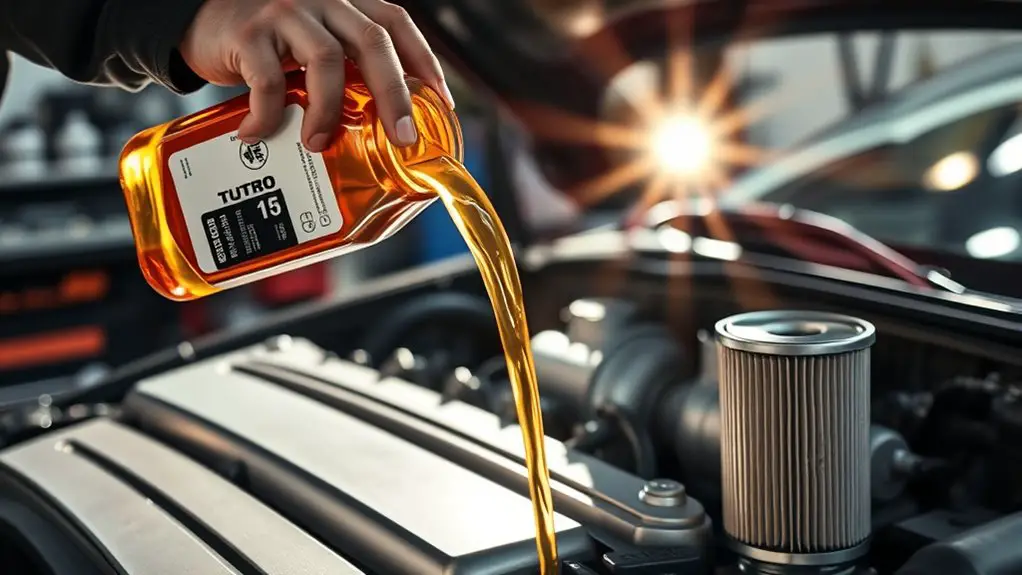
Regular oil changes are vital for maintaining the longevity and performance of high-mileage cars. Clean oil guarantees ideal engine lubrication, reduces wear, and prevents overheating. Choosing the right oil and adhering to recommended change intervals are fundamental practices for effective engine maintenance.
Importance of Clean Oil
Ensuring your car has clean oil is essential for maintaining its performance, especially when it has high mileage. Clean oil enhances oil viscosity, which is vital for optimal lubrication, contributing to engine longevity. Here’s why regular oil changes matter:
- Reduces Engine Wear: Contaminants in dirty oil increase friction, leading to accelerated wear on engine components.
- Maintains Efficiency: Clean oil flows better, improving fuel efficiency and overall engine responsiveness.
- Fights Deposits: Regular changes prevent sludge buildup, ensuring your engine runs smoothly and reliably.
Choosing the Right Oil
Clean oil is only part of the equation when it comes to maintaining a high-mileage car; selecting the right type of oil is equally important. Synthetic oils offer superior lubrication and stability compared to conventional oils, especially under extreme conditions. When choosing oil, consider the oil viscosity, which affects flow and protection. Thicker oils can provide better cushioning for worn components, while thinner oils may enhance fuel efficiency. However, always refer to your manufacturer’s specifications to guarantee compatibility. Using the correct synthetic oil with the appropriate viscosity not only helps prevent turbo lag but also prolongs engine life. Make informed choices to enjoy the freedom of a well-maintained vehicle that performs at its best, regardless of its mileage.
Recommended Change Intervals
While it’s crucial to choose the right oil for high-mileage vehicles, adhering to recommended change intervals is equally important for sustaining engine performance. Regular oil changes keep your engine running smoothly, preventing turbo lag and prolonging its life. Here are some key change intervals to take into account:
- Every 3,000 to 5,000 miles – For conventional oils, this guarantees ideal lubrication.
- Every 7,500 miles – For synthetic oils, this can enhance engine efficiency and reduce wear.
- Check maintenance schedules – Always refer to your owner’s manual for specific recommendations.
Inspecting and Replacing Air Filters
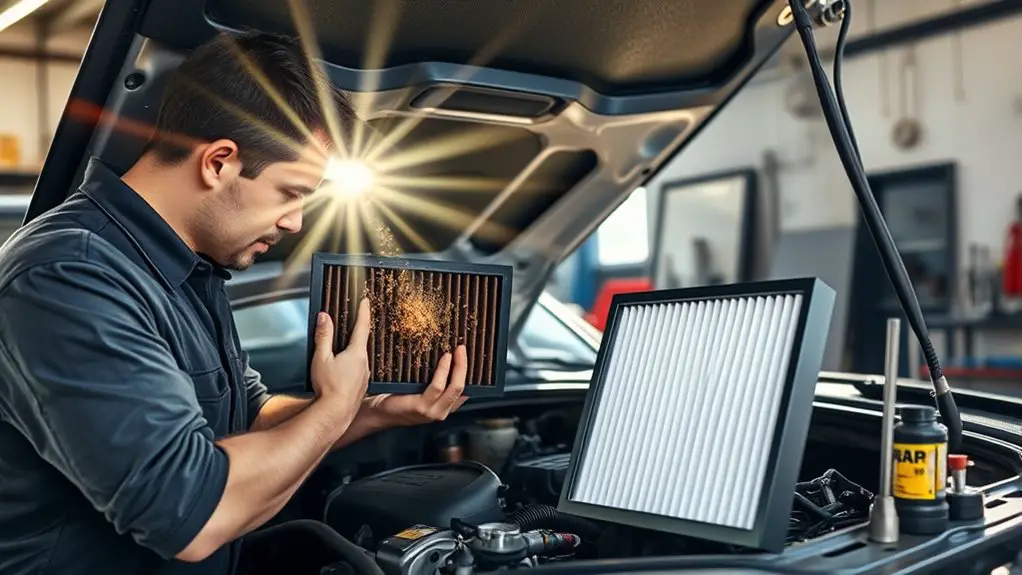
Air filters play an essential role in maintaining engine performance, as they prevent dirt and debris from entering the combustion chamber. For high-mileage cars, regularly inspecting and replacing air filters is vital to avoid turbo lag and guarantee peak airflow. There are various air filter types, including paper, foam, and cotton, each with unique benefits and limitations. Assess your vehicle’s specifications to determine which type suits your needs best.
During inspection, look for signs of clogging or damage, as a compromised filter can hinder engine efficiency. If you notice excessive dirt or your car’s performance declines, it’s time for filter replacement. Generally, it’s advisable to replace air filters every 15,000 to 30,000 miles, but check your owner’s manual for specific recommendations. By staying proactive with air filter maintenance, you’ll enhance your engine’s longevity and performance, granting you the freedom to enjoy your driving experience without interruptions.
Monitoring and Maintaining Coolant Levels
Maintaining ideal coolant levels is essential for high-mileage vehicles, especially after ensuring your air filters are clean to support overall engine performance. Neglecting this crucial fluid can lead to overheating and severe engine damage. To keep your engine running smoothly, focus on these key actions:
- Regular Temperature Monitoring: Always check your temperature gauge while driving. If it’s running hotter than normal, it’s time to investigate coolant levels.
- Routine Coolant Flush: Every 30,000 miles or as recommended by your manufacturer, a coolant flush removes sludge and contaminants, ensuring optimal flow.
- Visual Inspections: Periodically inspect your coolant reservoir for proper levels. If it’s low, top it up with the appropriate mixture to prevent overheating.
Checking and Servicing the Turbocharger
Since turbochargers greatly enhance engine performance, regular checking and servicing are vital for high-mileage cars. You should start with routine turbocharger maintenance, which includes inspecting the intake and exhaust sides for any signs of wear or damage. Use inspection techniques like visual checks and pressure testing to guarantee everything operates smoothly. Pay attention to oil supply lines for leaks or blockages; inadequate lubrication can lead to catastrophic failure.
Additionally, assess the boost pressure and response times; any significant lag may indicate underlying issues. Cleaning the turbocharger’s compressor and turbine wheels can improve efficiency, so consider doing this periodically. Don’t forget to check the wastegate operation, as it plays a key role in maintaining ideal boost levels. By adhering to these practices, you’ll not only prolong the life of your turbocharger but also maintain the performance integrity of your high-mileage vehicle.
Keeping the Exhaust System in Good Condition
Maintaining your exhaust system is essential for peak performance and emissions control in high-mileage vehicles. Regular inspections help identify issues early, while promptly addressing any leaks can prevent further damage. Additionally, considering wise upgrades to components can enhance longevity and efficiency.
Regular Exhaust Inspections
To guarantee peak performance and longevity of high-mileage cars, regular exhaust inspections are essential. A well-maintained exhaust system not only improves exhaust flow but also guarantees efficient emission control. Here are three reasons to prioritize these inspections:
- Enhanced Performance: A properly functioning exhaust system maximizes your engine’s efficiency, giving you that exhilarating freedom on the road.
- Reduced Emissions: Regular checks help maintain ideal emission control, keeping your car environmentally friendly and compliant with regulations.
- Cost Savings: Identifying issues early prevents costly repairs down the line, allowing you to allocate resources to more enjoyable pursuits.
Addressing Leaks Promptly
When you ignore leaks in your exhaust system, you risk not only diminished performance but also potential engine damage. Effective leak detection is vital for maintaining your vehicle’s efficiency. Regularly inspect the exhaust for cracks, holes, or loose connections that could lead to escapes of exhaust gases. If you identify any issues, prompt seal replacement is essential to restore ideal function. Delaying repairs can result in increased turbo lag and greater strain on your engine, ultimately leading to more costly repairs. By addressing leaks immediately, you not only enhance your car’s performance but also contribute to a healthier engine lifespan. Stay vigilant and proactive; your car will thank you with improved responsiveness and freedom on the road.
Upgrading Components Wisely
While upgrading components, it’s vital to evaluate how each modification affects the integrity of your exhaust system. Poor choices can lead to decreased performance and unnecessary turbo lag. To make informed decisions, consider these significant factors:
- Material Quality: Opt for lightweight, durable materials that enhance exhaust flow without compromising strength.
- Compatibility: Verify your upgrades align with existing components to avoid bottlenecks that hinder performance enhancements.
- Installation Precision: Proper installation is important; even minor misalignments can disrupt exhaust flow and power delivery.
Frequently Asked Questions
How Can Driving Habits Affect Turbo Lag in My Car?
You know what they say, “Slow and steady wins the race.” Your driving habits can greatly affect turbo lag. Using a smooth acceleration technique helps maintain boost pressure, reducing lag during acceleration. Additionally, your shifting patterns matter; shifting too early can cause a drop in RPM, slowing down turbo response. By mastering these techniques, you can enjoy a more responsive engine, giving you the freedom to release the power at your command.
What Signs Indicate My Turbocharger Needs Immediate Attention?
If you notice unusual turbo noises, like whistling or grinding, it’s a sign your turbocharger needs immediate attention. Additionally, check for oil leaks around the turbo area; this could indicate a failing seal or bearing issue. Both symptoms can lead to reduced performance and potential engine damage. Addressing these issues promptly can help maintain your vehicle’s performance and guarantee you enjoy the freedom of driving without unexpected breakdowns.
Can Using Premium Fuel Reduce Turbo Lag Issues?
“You get what you pay for.” Using premium fuel can indeed reduce turbo lag issues. Premium fuel benefits include higher octane ratings that improve combustion efficiency, enhancing turbo performance. By minimizing knocking and optimizing ignition timing, your engine operates more smoothly, reducing the chances of lag. While it’s not a cure-all, consistently using premium fuel can help maintain your vehicle’s responsiveness, giving you a more exhilarating driving experience.
How Often Should I Check the Turbocharger’s Boost Pressure?
You should check the turbocharger’s boost pressure every 5,000 to 7,500 miles or during routine turbocharger maintenance. Regular boost pressure monitoring helps identify any inconsistencies that could indicate issues, such as leaks or wastegate problems. Keeping an eye on this parameter guarantees your system’s efficiency and performance, allowing you to enjoy the full power of your vehicle. Staying proactive with checks can prevent more significant issues down the line, maintaining your freedom on the road.
Does Weather Impact Turbo Lag Performance in My Vehicle?
Yes, weather does impact turbo lag performance in your vehicle. Temperature fluctuations can affect air density, which in turn influences the turbocharger’s efficiency. Cold air is denser, providing better combustion and quicker spool-up, reducing turbo lag. Conversely, hot weather can lead to reduced performance due to thinner air. Additionally, humidity levels can also play a role, potentially causing variations in boost pressure and lag response. Regular monitoring can help mitigate these weather effects.

